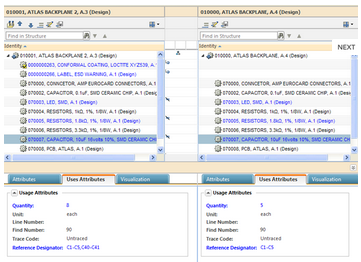 When considering how to get the most value from your PDM system, it can be helpful to review certain indicators of performance, such as:
When considering how to get the most value from your PDM system, it can be helpful to review certain indicators of performance, such as:
- Average time taken to design a new part and bring it into manufacture.
- Frequency of engineering changes arising from components not meeting market requirements.
- Percentage of designer’s time spent on non-productive data management.
- Product warranty trends.
- PDM related cost.
- Incidence of incorrect or duplicate information
Take some time out with your team and ask: What do we expect to gain from our product data management system? This will be an opportunity for your team to share their concerns and the answers will show whether the problems are internal, related to your current package, or because your needs have changed.
Involve your design office and don’t forget to include your procurement, quality, manufacturing, and other relevant departments, as they will have first hand experience of any PDM related problems. Check your work procedures, verify that they are valid and reflect the current configuration of the system. Then, from this initial analysis, you can start to look more in-depth at the key factors that will affect the success of PDM for your company.
Training
One of the frequent reasons for poor performance is inadequate employee training. Over a period of time, new employee appointments will be made, possibly without PDM training. Current employees may develop bad habits or take shortcuts.
Regular training courses managed in-house, by an experienced consultant, or through your PDM supplier’s in-house training facility will ensure your team is competent.
Integration with Other Software Packages
PDM is just one aspect of product lifecycle management (PLM). PLM incorporates all activities from the birth to death of a product and encompasses several functions such as CAD, Purchasing, ERPM, and Manufacturing. These different functions will have some level of system integration, but is it adequate? In your needs analysis you will have identified problem areas, and it is likely that some will relate to how your different systems share data. Where possible, you should ensure that data is entered only once, avoiding the risk of duplication and data entry errors. Optimising system integration will reduce errors.
Have You Got the Right PDM Package?
This is a tough question to ask, but your original PDM may be several years old. Is it still relevant to your needs? Your company, as well as your products may have changed quite considerably since your initial implementation.
As part of the needs analysis suggested earlier, it is worth evaluating competitive products to assess the best way of meeting your organisation’s needs. If your company is medium sized you could consider PTC’s Creo Elements/Direct model Manager, alternatively if it is large, complex, and operating over several geographically separate sites, you may find that PTC Windchill is more suited to your needs.
Product Improvement Programme
One useful method of enhancing the performance of your product data management system is to identify areas of improvement, set specific targets, and implement an action plan to achieve those goals. For example, you may decide to tackle quality costs by reducing scrap and rework rates. Or, you could target to reduce overhead costs associated with product management or the amount of time design staff spend on data retrieval and management. Formal improvement programs are very useful for improving effectiveness of your PDM.
Be a Top Company
Research shows that world-class companies have identified a strong link between effective product data management and product development performance. They also spend 15 per cent less of the design team’s time on data management than other companies. An interesting point is that product complexity, rather the company size, drives the need for effective product data management.
Find out more with our free guide to tackling prod-dev challenges:
